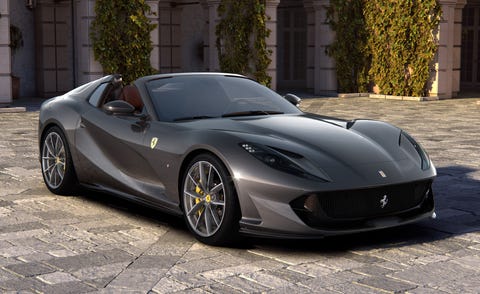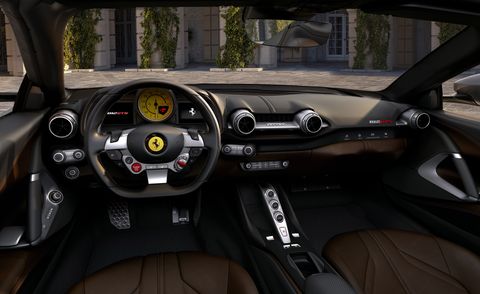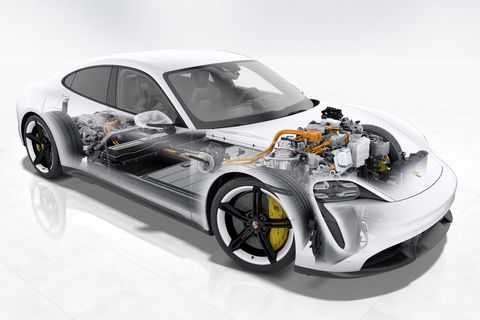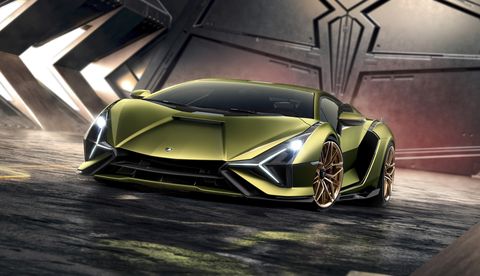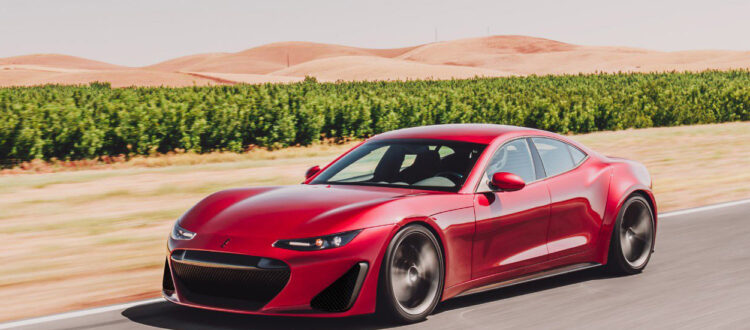Ferrari 812 GTS Has 789 HP and a Retractable Hardtop
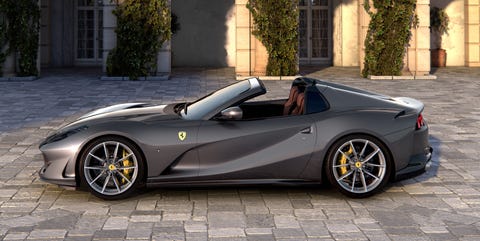
Ferrari unveiled the 812 GTS, its latest V-12 spider, in Maranello today. The car is based on the 812 Superfast, with which it shares its exterior and interior dimensions and its 6.5-liter, 789-hp V-12 engine. It features a power-folding hard-top and a rear end that was completely redesigned to accommodate the convertible top. Ferrari claims it is the most powerful production spider in the world.
Like in the 812 Superfast, the V-12 engine has an 8900-rpm rev limit, and makes its peak 789 hp at 8500 rpm. Torque hits its 530 lb-ft peak at 7000 rpm, with 80 percent of torque available at 3500 rpm. The seven-speed dual-clutch automatic transmission has been programmed for faster shifts, and now has shorter gear ratios to improve the 812’s response to throttle inputs. Ferrari says the GTS will reach 62 mph in less than three seconds and 124 mph in 8.3 seconds. The car will have a top speed of 211 mph.
The V-12 had to employ some tricks to comply with emissions regulations. Its high-pressure injection system reduces the number of particles that are emitted before the catalytic converter warms up. There’s also a new gasoline particulate filter, and the GTS uses a stop-start system to further mitigate the thirsty V-12’s demands.
The 812 GTS’s rear end features two buttresses and a tonneau cover. The mechanism that moves the power-folding hardtop lives under the buttresses, and when the top is stowed its panels rest under the tonneau cover. The top can fold or unfold in 14 seconds and will operate at speeds of up to 28 mph. An air duct that runs through the rear wheel arches in the coupe variant was lost in the redesign, so the GTS’s rear diffuser has an extra flap to make up the difference.
The 812 GTS is also the scion of a rich lineage for Ferrari. The company built its first front-engined V-12 coupe in 1948. That car, the 166 MM won both the Mille Miglia and 24 Hours of LeMans endurance races in 1949. The last time a series-production front-engine V-12 Spider rolled out of Maranello was the GTS4 in 1969, also called the Daytona Spider in honor of Ferrari’s 1967 sweep at the 24 Hours of Daytona (the company counts more recent front-engine V-12 cars such as the 575 Superamerica and F60 America as limited-edition models).
Ferrari hasn’t named an on-sale date or a price for the 812 GTS, but we’d bet it’ll be a bit higher than the coupe version, which rings in at a healthy $335,275.
By: Annie White, September 9, 2019
For more car, visit: https://www.caranddriver.com/news/a28955195/ferrari-812-gts-photos-info/
Source: https://www.caranddriver.com/
The 2020 Porsche Taycan Turbo S Is a 750-HP Electric Super Sedan
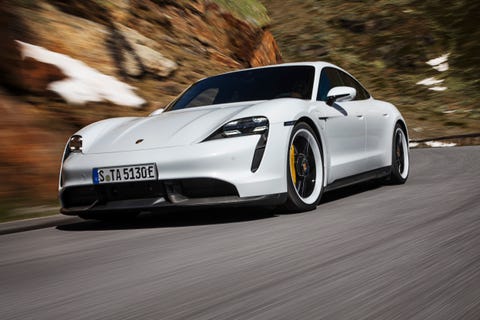
Porsche’s first production electric car is a big deal. Speaking to the engineers who created it, you get the sense that the Taycan isn’t just another model in the automaker’s lineup. It’s a paradigm shift, a clean-sheet engineering project. When Porsche does a clean-sheet project, it tends to end up pretty great—think of the 918, revolutionary upon its debut and still magnificent today.
But the Taycan is intended as a mass-produced electric sedan, a far cry from the hypercar exclusivity of the 918. And an all-electric car presents challenges that Porsche has never had to face before. The automaker invited journalists to its Atlanta headquarters for a deep dive into the production-spec EV. Here’s what we learned.
At launch, Porsche will offer two versions of the Taycan—the Turbo and Turbo S. (Yes, Porsche insists on carrying over this well-established model name on a vehicle that will never be equipped with turbochargers.) The Turbo will carry an MSRP of $153,510 at launch, while the Turbo S will cost $187,610. Both of those numbers are minus destination charge.
Both the Turbo and Turbo S will have two electric motors, one powering each axle. Porsche designed the permanent magnet synchronous machine (PMSM) motors in house—they’re more expensive to develop compared to traditional electric motors, but they’re easier to package, and more importantly, easier to cool. That’s critical because Porsche wants to provide sustained, repeatable performance with this car.
Both models offer 616 hp in normal driving. Activate Launch Control, and the Taycan Turbo / Turbo S will give you 2.5 seconds of “Overboost,” increasing output to 670 hp in the Turbo and 750 hp in the Turbo S. The results are serious: Porsche says the Turbo will do 0-60 mph in 3.0 seconds, 0-124 mph in 10.6 seconds, and the quarter-mile in 11.1 seconds, while the Turbo S will do 0-60 in 2.6 seconds, 0-124 mph in 9.8 seconds, and a 10.8-second quarter-mile.
Porsche fitted the Taycan’s rear motor with a two-speed gearbox. In Sport or Sport+ modes, the rear drive system starts out in low gear for improved acceleration; in other modes, it stays in high gear all the time. The rear motor also has an electronically controlled limited-slip differential. The front motor transmits power through a single-speed gearbox.
Both the Turbo and Turbo S get a 600-amp inverter for the rear motor, but while the Turbo uses a 300-amp inverter for the front motor, the S gets another 600-amp unit. That’s the biggest difference between the Turbo and Turbo S, though the S also gets 21-inch wheels, rear-wheel steering and carbon-ceramic brakes, all standard equipment. An engineer told R&T that the larger front inverter only plays a role in off-the-line acceleration—dynamically, the Turbo and Turbo S are essentially the same otherwise.
All of these drivetrain components were designed in-house by Porsche, and the motors, inverters, and two-speed gearbox will be built in the company’s hometown of Zuffenhausen. While Porsche won’t confirm it just yet, we expect the entry-level Taycan will feature a single electric motor powering the rear axle; a later Taycan 4S with twin motors seems likely as well, albeit with lower power output than the Turbo and Turbo S. In “Range” mode, all-wheel drive Taycan models will default to front-wheel drive, a Porsche first, to minimize energy consumption.
Just as important as the motors in an EV are the batteries that power them. The Taycan Turbo and Turbo S get a 93.4-kWh battery pack attached to the steel floorpan of the car. All Taycans will use an 800-volt electrical architecture that Porsche says will allow for very fast charging times.
At launch, Porsche says the Taycan will be able to handle 270 kW of input current, increasing to as much as 500 kW in the future. And Porsche promises a new 800-volt “Turbo” charging system will replenish a Taycan’s battery from 5 percent to 80 percent charge in just under 23 minutes. (After the battery reaches 80 percent, charging speed decreases notably, so Porsche says it’s best to just charge to 80 and be on your way.) These 800-volt chargers will eventually be conveniently located at Porsche dealerships and Electrify America charging stations.
While the EPA hasn’t rated the Taycan’s driving range just yet, Europe’s WLTP numbers indicate the Taycan Turbo should be able to cover up to 280 miles on a full charge, while in the Turbo S, that figure shrinks to 256 miles. Blame the S model’s larger 21-inch wheels for that discrepancy, and remember that WLTP testing often returns higher range numbers than EPA measurement. Those numbers are considerably smaller than a comparable Tesla: the EPA estimates range of 345 miles for the Tesla Model S Performance, rising to 370 miles for the Long Range.
Lamborghini Sián Kicks Off Lambo’s Hybrid Era with 807 HP and a 218-MPH Top Speed
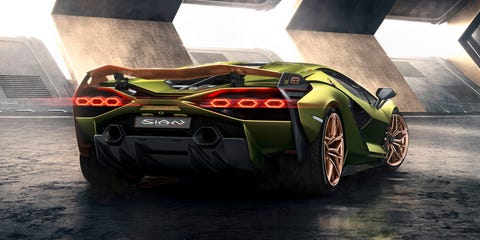
After eight years, the Lamborghini Aventador isn’t done shocking the world with its jagged-edge design and flame-throwing exhaust. Like the Veneno and Centenario, the new Sián is a hypercar built off a heavily-modified Aventador—only now, it’s a hybrid.
That the Sián’s electric motor contributes but 34 horsepower to an 807-hp powertrain is the one puzzling stat. What, exactly, would anyone gain when the 6.5-liter V-12 is pushing 774 hp—15 more than the Aventador SVJ—the most ever from a Lambo engine? The engineers claim quicker midrange acceleration, better response between shifts, additional torque off the line up to 81 mph, and the convenience of parking a Lambo without the V-12 engine sputtering and begging the driver to launch out of the garage. Bless the Sant’Agata team for prioritizing objectives in their first-ever hybrid project. Engineers working on the first Honda Insight no doubt had similar wants and needs.
The Drako GTE is a 1,200bhp, 206mph Electric GT Car
Hello muggles, and welcome to the mind-bendingly quick Drako GTE. Not as quick as travelling by floo powder of course, but you non-magic types will have to deal with what you’re given.
Apologies, we’ll stop the Harry Potter references right away – it’s not even spelt the same as Master Malfoy’s first name.
Welcome to the first car from Silicon Valley start-up Drako Motors. It’s based on the chassis of the old Fisker Karma, but claims to be a fully-electric four-seat supercar rather than a hybrid luxury barge.
It’s rapid too, four electric motors (one at each wheel) combine to produce a total of 1,200bhp and a monumental 6,500lb ft of torque – powering the GTE to a top speed of 206mph.
There’s no word on how long you’ll be able to use that performance for, but those motors draw their power from a 90kWh battery pack that’s mounted in the floor for a low centre of gravity. For comparison, you can have your Tesla Model S with either a 75 or 100kWh battery.
Drako claims that the GTE will feature “cornering precision unlike any other supercar on the road today” thanks to Öhlins suspension, Brembo carbon ceramic brakes and an apparently industry-leading torque vectoring system that can shift power between each individual wheel over 1,000 times per second. It was developed on the Nürburgring too – so make of that what you will.
There’s also a huge array of different driving modes thanks to the programmable electric motors. Drako is calling the four different switches its ‘Quattro Manettino’ – presumably in a move designed to annoy the copyright lawyers of both Audi and Ferrari. Note the drift mode in there though – this is good news.
More good news comes from the fact that the car you see above is a fully-functional, production-ready example. That means orders are now open, although production will be limited to just 25 examples. That’s a shame, as is the $1.25m (£1m) base price.
Looks pretty sleek though, right? Those grilles at the front aren’t just for show either. Three oversized radiators are used to cool the mega battery pack. What do you think, Internet?
By: Greg Potts, August 19, 2019
For more cars, visit: https://www.topgear.com/car-news/electric/drako-gte-1200bhp-206mph-electric-gt-car
Source: https://www.topgear.com/
The 591-HP Audi RS6 Avant Is Really, Truly Coming to America
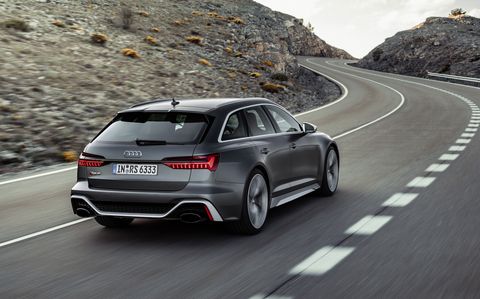
Good news for wagon fans: Audi is bringing the RS6 Avant to North America for the first time in Audi Sport’s 25-year history. The new performance wagon will go up against its most direct competitor, the Mercedes-AMG E63 S wagon, as well as the Porsche Panamera Turbo Sport Turismo and the Jaguar XF Sportbrake.
Step one in the battle for supremacy in the hot-rod-wagon segment is power. The RS6 Avant is powered by a twin-turbo 4.0-liter V-8 partnered with a 48-volt hybrid system that produces 591 horsepower and 590 pound-feet of torque. The wagon’s claimed zero-to-62-mph time is 3.6 seconds, and it clears 120 mph in less than 12.0 seconds. It will have to outperform those estimates to beat the 603-hp E63 wagon, which went from zero to 60 mph in 3.0 seconds and from zero to 120 mph in 10.2 seconds in our testing.
The RS6 Avant can hit 190 mph with the Dynamic Package Plus, which includes the RS adaptive air suspension. With the standard Dynamic package, the top speed is 174 mph, while the standard model tops out at 155 mph. Whether or not U.S.-spec cars get the multiple speed governors is TBD.
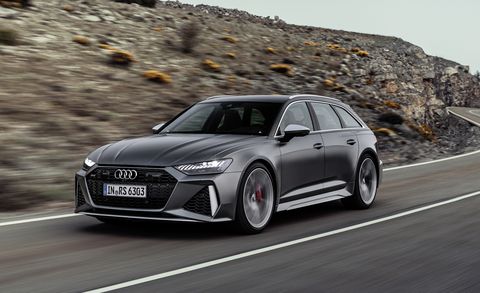
A standard eight-speed automatic transmission with a launch-control function sends torque to a permanent all-wheel-drive system. The Quattro’s standard distribution is 40:60 to the front and rear axles, but if there is any slippage the system will compensate by sending more power to the axle with better traction (up to 70 percent to the front axle, up to 85 percent to the rear).
All this performance comes with some nods to efficiency. A cylinder deactivation system can shut down the valves and fuel injection to four of the cylinders between low and intermediate loads and speeds. The RS6 Avant’s 48-volt belt-driven motor/generator can recoup up to 12 kW during regenerative braking between 34 and 99 mph and store it in a small, dedicated lithium-ion battery.
Only three exterior parts—the front doors, the roof, and the tailgate—are carried over unchanged from the base A6 Avant to the RS6. Everything else you see is an RS-specific part, from the honeycomb-look grille in gloss black to the new bumper with design echoes from the Audi R8 supercar. The headlights come from the A7, which means optional RS Matrix LED laser lights with darkened trim are available. The RS6 Avant also has a 3.1-inch-wider and 0.8-inch-lower body than the A6 Avant. It rides on standard, 21-inch cast aluminum wheels with a 10-spoke design or on optional 22-inch wheels with a 5-spoke design.
Inside, the RS6 Avant features premium materials including RS-embossed black pearl Nappa leather and Alcantara. Heated and cooled RS sport seats trimmed in Valcona leather with a honeycomb pattern are available. Audi’s MMI dual-touchscreen system and Virtual Cockpit digital instrument panel bring safety and infotainment features to the driver’s attention, and an RS Monitor display offers up a more detailed look at things such as torque and power output, engine oil temperature, and boost pressure. The perforated leather sport steering wheel now offers RS1 and RS2 buttons that switch between two individually configurable RS drive modes. Comfort, Auto, Dynamic, and Efficiency driving modes are also on offer.
The reason the RS6 Avant is finally coming to the these shores is thanks to incessant requests from the U.S. division. “The guys from Audi of America did great in always pushing and getting the customer’s needs to us in headquarters,” Audi marketing manager Linda Kurz said. “We understood that the Avant has a chance for the U.S. market. In the previous generation we couldn’t make it happen, but now we decided with our colleagues in the U.S. that we would have it on offer.”
The RS6 Avant will go on sale in the U.S. in the second or third quarter of next year as a 2020 model following its debut in Europe in the first quarter. Expect its starting price to be near that of the Mercedes-AMG E63 S wagon, which starts at $112,745.
By: Sebastian Blanco, August 20, 2019
For more cars, visit: https://www.caranddriver.com/news/a28747885/2020-audi-rs6-avant-photos-info/
Source: https://www.caranddriver.com/
Novitec’s Ferrari 488 Pista
Pagani Huayra BC Roadster Is Beautiful Enough to Justify Its $3.4 Million Price

The Pagani Huayra BC roadster will carry a factory-gate price of $3.4 million before local taxes. Even though only 40 will be produced, and they will be the last in the Huayra line, that is a ridiculous amount of money—more than triple what was charged for the first Huayra coupe in 2011.
And yet, we challenge you to spend a couple of minutes looking at these images and say that figure isn’t entirely justified.
In fact, the BC roadster is the finest-looking memorial in the world. Like its coupe sister, named after an Italian-American entrepreneur called Benny Caiola, who was better known among gearheads for having one of the world’s largest collections of Ferraris. When the tiny Italian supercar maker Pagani was starting out, Caiola was the man who placed the first ever order for one of its products. He died in 2010, but Horacio Pagani’s gratitude to his debut customer means his initials have been incorporated into the ultimate version of the Huayra.
While all Paganis are special, some get to be more special than others. The regular Huayra spawned both roadster and dynamically focused BC models, with this last-of-line special being a combination of the two. Roadsters are normally heavier than their fixed-roof sisters, but the Huayra has bucked the trend thanks to the use of an ultralight removable carbon-fiber hard top. The BC roadster is slightly heavier than the BC coupe, but, according to Pagani claims, it weighs just 2756 pounds, 66 pounds less than the regular roadster.
The monocoque structure incorporates even lighter materials than regular carbon fiber, including what we’re told is carbon-titanium HP62, making it both lighter and stronger. Lower body aero elements and the vast rear wing work together to produce a claimed peak of 1102 pounds of downforce at 174 mph. In addition to movable active elements, the titanium exhaust incorporates flaps in the catalytic converters to divert exhaust gases over the underfloor elements like a Formula 1 car’s blown diffuser. The exhaust pipes still use the two-by-two quad layout that Pagani pioneered with the original Zonda.
Many parts of the interior are closer to art than automotive design, with details like the gorgeous exposed metal gear selector showing the obsessive attention to detail of company founder and chief designer Horacio Pagani. It would have been so much easier to give the car a more conventional shifter, but so much less stylish. The seats also incorporate a deep slash in their backrests, presumably to enhance occupant cooling when the car is being driven in direct sunlight.
As in other versions of the Huayra, power comes from a uniquely tuned version of the Mercedes-AMG M158. This twin-turbocharged V-12 makes 791 horsepower and accompanies it with 775 lb-ft of torque available from 2000 rpm to 5600 rpm. Drive is delivered to the rear axle through a seven-speed single-clutch automated gearbox. Pagani hasn’t released acceleration claims—we doubt they would be tardy—but does say that the car can generate up to 1.9 g’s of continuous lateral acceleration during hard cornering, with face-distorting peaks of up to 2.2 g.
While we’re told that the BC roadster is the ultimate Huayra, there’s no guarantee it will actually be the last one. Horacio Pagani has always found it difficult to say no to the demands of his customers, with the company’s original Zonda kept in limited production for years as affluent buyers, including F1 driver Lewis Hamilton, begged for the chance to buy one. Horacio admits that plans to retire the Huayra with the BC roadster might slip.
“It is scheduled to be the last production model,” he told us at the Goodwood Festival of Speed, “but I am also listening to some private collectors who are asking maybe for a one-off or a limited edition, which will probably extend the life span a little more.”
By: Mike Duff, July 31, 2019
For more cars, visit: https://www.caranddriver.com/news/a28552297/pagani-huayra-bc-roadster-photos-info/
Source: https://www.caranddriver.com/
The New Mid-Engined Chevrolet Corvette Stingray
Angular, isn’t it? Very creasy-y. Sharp-looking. The 2020 Corvette Stingray is here.
It’s here at last, and yep, the engine’s in the middle. That engine being a 6.2-litre, naturally aspirated smallblock ‘LT2’ V8, sending 495bhp and 470lb ft to the rear wheels via a rear-mounted eight-speed dual-clutch gearbox.
If you’re a Brit, we’ve some good news: this one’s for you. Right-hand drive is, at long last, coming to the Corvette.
With the Z51 package fitted (which adds a sports exhaust, adjustable suspension, bigger brakes, better cooling and a spritelier final drive ratio) Chevy claims the Stingray will get from 0-60mph in around 3.0 seconds, making it the fastest ‘entry-level’ Corvette ever.
And it’s not just speedy in a straight line. The front splitter and rear wing generate a claimed 180kg of high-speed downforce for better cornering. There’s a Ferrari-style electronic rear diff. Optional magnetic-adaptive suspension, for, well, you get the idea. It’s got a dry-sump oil system so the engine stays lubricated when the car’s pulling big Gs. This isn’t just a hot-rod with its motor in the middle, promises Chevy. It’s a true supercar that can run with the European elite. And supposedly, it’s practical too.
Want to carry two sets of golf clubs? No, us neither. But apparently some supercar buyers do, for some reason, so the Corvette Stingray has two boots. Or trunks, if you must. One in the front, and one in the back, which can also swallow the targa roof panel.
Together, the trunk and frunk add up to offer 357-litres of boot space. And the cabin’s roomier too. And cleverer. Look at that 12-inch digital instrument display. At last, we’ve got a Corvette with an interior that looks like it came from the country that invented the iPhone, instead of the country that also invented spray-on cheese. Though what’s going on with that super-long strip of buttons? Did Chevy forget to put the heater controls in until yesterday?
Underneath, Chevy has gone for an aluminium chassis instead of a McLaren-style carbon tub, to keep the car affordable (the base-spec will cost under $60,000). TG’s spoken to Alex MacDonald, the guy in charge of setting up how the new Stingray drives, and quizzed him on the new chassis and some of the crazy rumours that’s followed the new Vette for years. Check out his answer as he sets the record straight here.
Of course no modern sports car would be complete without an armada of modes to fiddle with. So, in addition to Weather, Tour, Sport and Track settings, the new Stingray offers two new modes to play with. There’s MyMode – basically a cherry-pick-your-faves individual setting. And finally, a ‘Z’ mode, which is, well, a bit confusing really.
Chevy says “Z mode is named after the famed Z06, ZR1 and Z51 Corvette performance packages. It’s activated through a ‘Z’ button on the steering wheel. This is a single-use mode that takes MyMode configurations one step further, allowing drivers to adjust the engine and transmission as well”.
So, Z mode is like MyMode, but more so. The Corvette Stingray turned up to eleven, if you like.
Oh, you don’t like. Want something more comfy, do you? Well the Stingray reckons it’s got that sussed out too. There’s wireless smartphone charging, a heated steering wheel, Bose audio, and on-board cameras to capture your best lap times for posterity. And your biggest shunts for YouTube infamy.
But for now, all of that can wait. No lap time chat, no ‘will it beat a Tesla in a drag race’ semantics. Only one thing matters right now. Do you like the way the Stingray looks?
By: Ollie Kew, July 19, 2019
For more cars, visit: https://www.topgear.com/car-news/supercars/new-mid-engined-chevrolet-corvette-stingray
Source: https://www.topgear.com/
The Hennessey Goliath 6×6
This is the Lotus Evija: a 1,972bhp Electric Hypercar
The name. Before we get to the looks of Lotus’s first hypercar, the power of Lotus’s first hypercar, or why indeed Lotus thinks it can blindside Bugatti and co, let’s deal with the name. What four-wheeled unobtanium would dare show its angular face in Casino Square or a climate-controlled Abu Dhabi garage without a Countdown wordjumble branded on its backside?
You’ve deciphered Huayra, Rimac, and Koenigsegg. Now, limber up your jowls and stretch your lips around this: Evija. No, not ‘ee-vee, yahh’, like some Made In Chelsea mannequin guffawing over a Nissan Leaf. It’s “Evv-eye-ah”. Could have sworn she was one of the minor Stark children from Game of Thrones, but apparently it means ‘the first in existence’. Roughly, it translates from Hebrew as ‘living, to breathe’. And it begins with the letter E, which ought to keep the Lotus purists happy. Little else about the Evija will.
Welcome to the age of the electric hypercar, and Britain’s first entrant. Whether or not this will be a long chapter in the history of very fast cars, or a curious cul-de-sac on the way to future forms of power and performance remains to be seen. But Lotus isn’t waiting to see which way the tech wind blows and then cash in its Chinese-funded chips.
The latest corporate giant to tee up a Lotus moonshot and propel it into exotica’s premier league is Geely, China’s third-largest carmaker and backer of a resurgent Volvo, start-up carsharers Lynk&Co and the new London black cab company. And what does the portfolio have in common? A headlong dive into electrification. From Polestar to hybrid cabs and now to rural Norfolk – where all 130 Evijas will be built – Geely wants to conquer the world with belief in batteries. And it’s fallen on Lotus to wade into battle against the upstart likes of Rimac, Pininfarina and, dare we say it, Tesla.
While you’re still digesting the looks, I’ll divulge what we possibly can about the Not-Oily-Bits. When word first filtered onto the internet about Lotus’s mystical ‘Type-130’ project, the power figure being mooted was a nice, round 1,000bhp+. Four-figure horsepower has quickly gone from being the preserve of Bugatti and Koenigsegg to the minimum requirement for a newbie to be taken seriously.
And when it comes to electric hypercars, the numbers really are bananas. The Rimac C_Two promises 1,888bhp. Pininfarina’s Battista rounds that up to 1,900bhp. It’s the end of car tuning as we know it. So long as the processors can handle the maths, you can pretty much name your power output. And to hell with what the tyres can manage.
Lotus says its target is to be the world’s most powerful production car, with 2,000PS, or 1,972bhp. Torque, totalling some 1,700Nm (1,253lb ft – over double what a McLaren Senna churns out) will be vectored between all four wheels, because yep, it’s four-wheel drive. Lotus’s first road-legal 4×4 isn’t the long-mooted SUV after all.
These power boasts are nigh-on impossible to get your head around. And that’s unusual for a Lotus, because instead of asking ‘how have you made it so light’, we’re left wondering ‘why is it so powerful.’ But Louis Kerr, the chief Evija platform engineer, insists Lotus isn’t switching focus from weight-saving to power-craving. “Light weight and efficient, elegant engineering have always been at the heart of the Lotus DNA. That will not change”, he promises Top Gear.
So, the weight. Again, we’re only being fed preliminary figures, but the target spec is 1,680kg ‘in lightest specification’. Hypercar buyers will pay through the nose and back again to cut kilos, as evidenced by the unpainted, trim-shorn Porsche 918 Spyder mit Weissach Pack. Still, with a driver on board, no amount of carbon trim is going to get the Evija under 1.7 tonnes. Hefty for a Lotus. And massive – it’s Aventador-big. Two metres wide. Is this really the right direction for supercars to plunge in?
The good news is it’s a third of tonne lighter than the 1,950kg Rimac, so while it’s not a feather per se, it’s the least leaden of the new e-hypercar breed. And the balance, despite the batteries being heaped up under the Not-Engine-Bay window, is spread 50:50 between the axles.
The performance claims sound coy for something that weighs the same as a 5 Series diesel but has more power than three M5s. Right now the targets are 0-62mph in sub-3sec, 0-186mph in sub-9sec (a Chiron takes 13.6sec) and a top speed north of 200mph. Once it’s off the line and the torque-vectoring is doing its thing, acceleration should be savage. And silent. Louis makes no mention at all of any attempt to give the Evija a soundtrack, beyond the “digitally created sound required by regulations to alert pedestrians to its presence”.
Surely the looks will have alerted folk to the spaceship whispering past their navel? You’ve never seen a vehicle like this. Norfolk residents who spot one undergoing shakedown will feel like those old Navy pilots who caught glimpses of the secret SR-71 Blackbird. What the heck was tha- oh, it’s gone.
All 130 individuals who spend £1.5m-£2m on an Evija (plus taxes, thankyouverymuch) are getting a whole lot of nothing for their money. Or as designers prefer to call it, ‘negative space’. Lotus’s deign boss Russell Carr explains that EVs give him a whole new toybox to unlock.
“The packaging of the battery pack and rear motors offers some flexibility when designing the rear bodywork and diffuser. This has helped us create the distinctive Venturi tunnels. Cooling requirements are less aggressive than on a 1,000hp+ combustion powertrain, and this has allowed us this ‘porous’ quality, with air going through the car.”
It’s incredible , but what exactly makes this a Lotus, looks-wise?
“The prominent muscular haunches and low-mounted cabin has been a feature of Elise and Exige, as well as sports racing cars like Type 11 and Type 40,” says Russell. “The side profile line for the intake of the rear quarter panel Venturi tunnels is reminiscent of that used on the more traditional intakes in the Elise and Exige.”
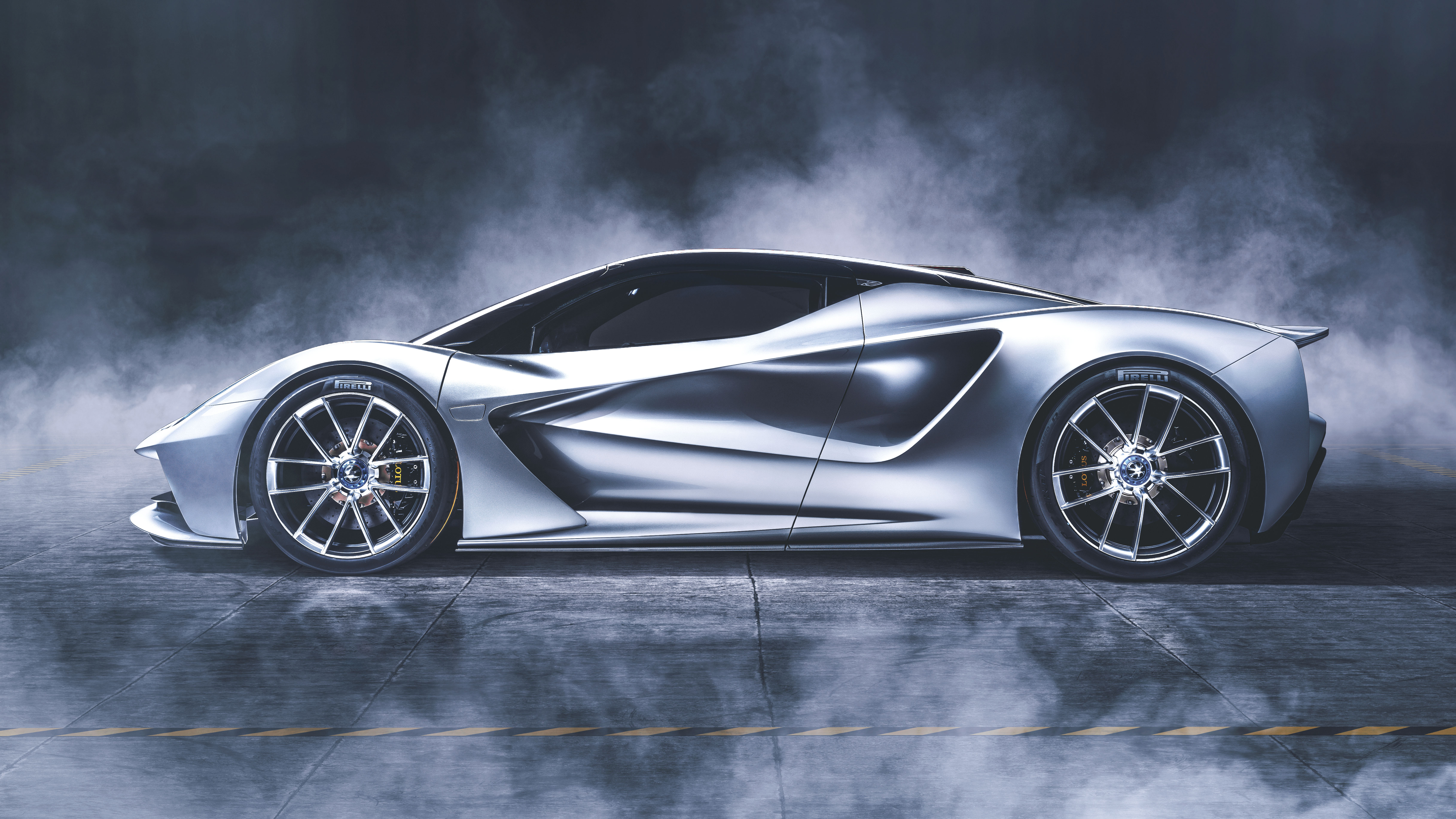
Lotus’ design boss is adamant that a deliberately retro-inspired-design, like the latest Ford GT, was never on the table. Neither, says engineering, was a hybrid drivetrain. The Evija is a virtuous circle. No engine means less cooling, means neater packaging, means slicker aerodynamics. Those rear tunnels are outrageous, aren’t they? What’s fascinating is how the car seems to shapeshift as you walk around it, like a piece of perspective art hung in a gallery.
From the front-three quarter, it’s a solid object, of punchy stance and brooding haunches. Take a broad step to your left or right. Suddenly, voids open before your very eyes. Light pours through gaping chasms in the car’s shoulders. Shadows are cast beneath the twin-skinned bonnet. The tyres peek through Le Mans racer-like vents ahead of the doors. Supercars always aim to look fast when they’re standing still. This thing looks like it’s coming apart at the seams.
Up until now, Lotus and Williams Advanced Engineering (who also have Singer’s F1-spec Porsche flat-six and the Dendrobium electric hypercar on their books) have been collaborating in simulator testing, but by the time you read this, Lotus will have put the finishing touches to its first rolling prototype.
We’re confidently told that the look won’t change from what you see before you. From the pop-out cameras for door mirrors to the inboard suspension visible at the nape of the rear window, it’s all approved. Hopefully the Huracán-esque interior, with its driver-selfish digi-screen and birthday card-sized steering wheel will be left untouched, too. Because you’ve never sat in a better put-together Lotus than this. It doesn’t even smell of fibreglass and panic.
Where, how or even why the Evija’s owners will deploy their new toy is a big conundrum to ponder, but Lotus is making nods to usability. The cabin controls are a doddle to suss out. Maximum cruising range is 250 miles – about what you’d get from a big V12 Lambo or Pagani, if you’re careful. Which you won’t be. Not with this much insta-poke. And it’ll fully recharge in 18 minutes. If you’ve got access to a 350kW charger. Great news, if you live in Kent. Because Kent’s home to the UK’s sole 350kW charger.
Still, 40 such chargers are planned for when Lotus begins production in 2020. Expect to see motorway services sales of WhatYacht? and The Mock Greek Pillar Journal skyrocket.
There’s a strange-yet-wonderfully true story that on 16th November 1990, the British Parliament debated the morality of Lotus to sell its 377bhp take on the Vauxhall Carlton: a family saloon with a top speed of 177mph. Thirty years on, Lotus is going to mic drop a two thousand horsepower road car on the world. Good job all our MPs are otherwise occupied.
By: Ollie Kew, July 16, 2019
For more cars, visit: https://www.topgear.com/car-news/electric/lotus-evija-1972bhp-electric-hypercar
Source: https://www.topgear.com/

